Analysis of Learning Culture Issues at Blitzen Engineering
VerifiedAdded on 2020/01/07
|9
|3295
|245
Report
AI Summary
This report analyzes the learning and development issues at Blitzen Engineering, a supplier of automotive components. It addresses the challenges of adapting to changes, developing leaders, engaging learners, and managing conflicts within the organization. The report identifies barriers to creating a learning culture, such as program focus, limited resources, and resistance to change. It emphasizes the importance of skill development programs, including the circumstances in which they might yield negative results, and discusses the appropriateness of a 'one size fits all' approach to human resource development. The report outlines the learning needs of different employee groups, including experienced workers and new graduates, and suggests appropriate methods of learning and development. It also explores expectations and responsibilities placed on employees as part of a continuous improvement drive and provides assessment points for gauging the progress of development within the organization. The report concludes by offering insights into how Blitzen Engineering can improve its learning culture and overall organizational effectiveness. This is a valuable resource for students studying leadership and management.
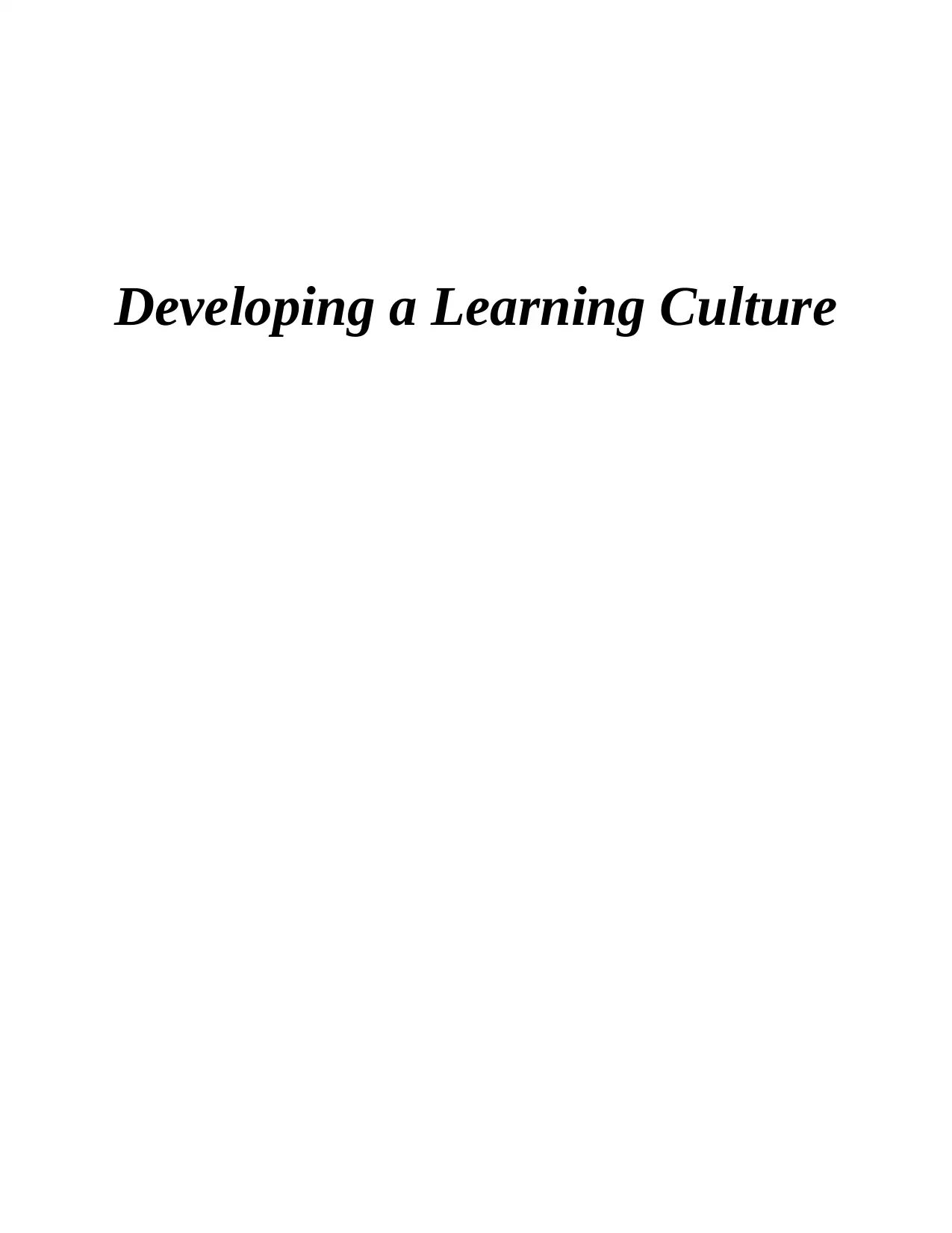
Developing a Learning Culture
Paraphrase This Document
Need a fresh take? Get an instant paraphrase of this document with our AI Paraphraser
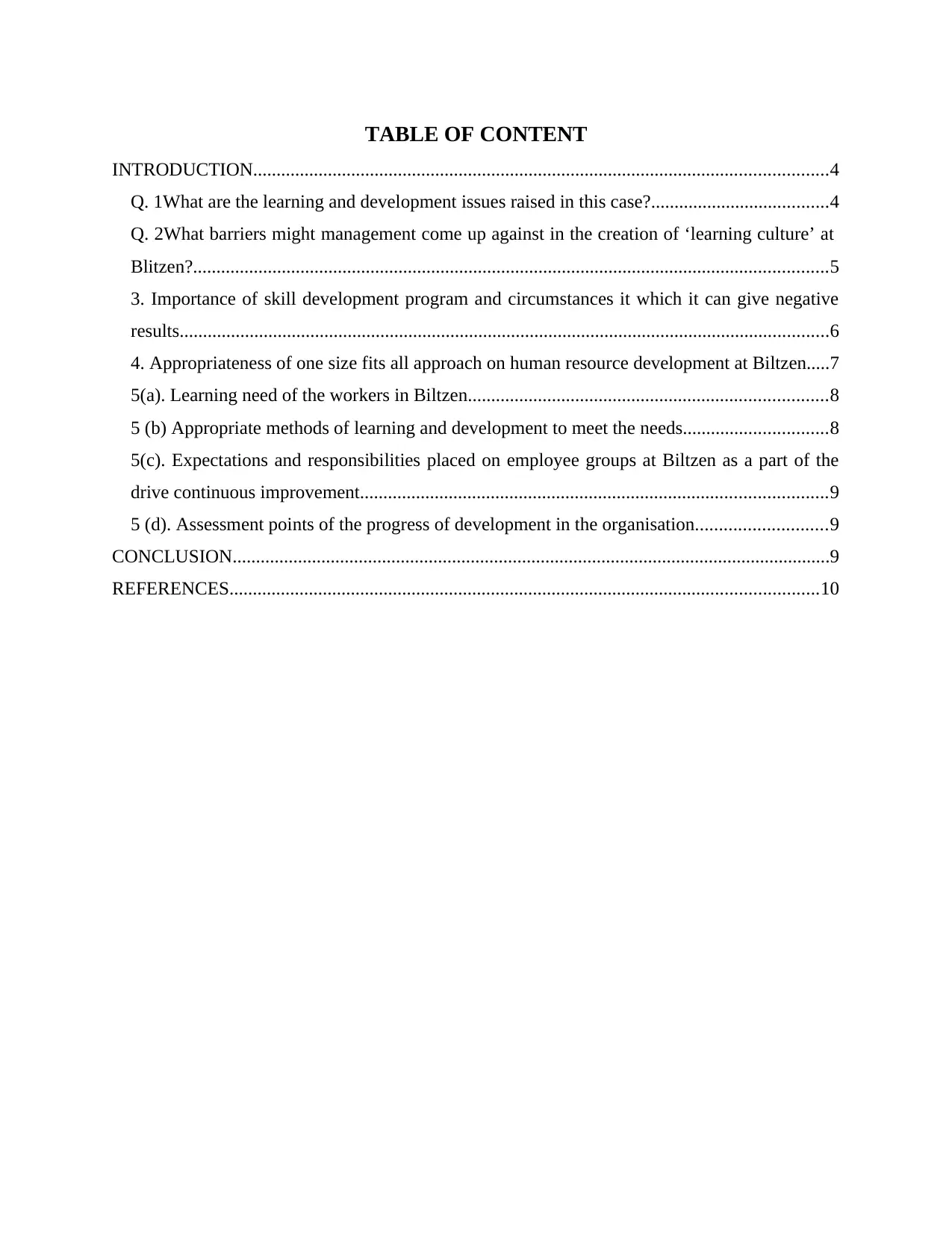
TABLE OF CONTENT
INTRODUCTION...........................................................................................................................4
Q. 1What are the learning and development issues raised in this case?......................................4
Q. 2What barriers might management come up against in the creation of ‘learning culture’ at
Blitzen?........................................................................................................................................5
3. Importance of skill development program and circumstances it which it can give negative
results...........................................................................................................................................6
4. Appropriateness of one size fits all approach on human resource development at Biltzen.....7
5(a). Learning need of the workers in Biltzen.............................................................................8
5 (b) Appropriate methods of learning and development to meet the needs...............................8
5(c). Expectations and responsibilities placed on employee groups at Biltzen as a part of the
drive continuous improvement....................................................................................................9
5 (d). Assessment points of the progress of development in the organisation............................9
CONCLUSION................................................................................................................................9
REFERENCES..............................................................................................................................10
INTRODUCTION...........................................................................................................................4
Q. 1What are the learning and development issues raised in this case?......................................4
Q. 2What barriers might management come up against in the creation of ‘learning culture’ at
Blitzen?........................................................................................................................................5
3. Importance of skill development program and circumstances it which it can give negative
results...........................................................................................................................................6
4. Appropriateness of one size fits all approach on human resource development at Biltzen.....7
5(a). Learning need of the workers in Biltzen.............................................................................8
5 (b) Appropriate methods of learning and development to meet the needs...............................8
5(c). Expectations and responsibilities placed on employee groups at Biltzen as a part of the
drive continuous improvement....................................................................................................9
5 (d). Assessment points of the progress of development in the organisation............................9
CONCLUSION................................................................................................................................9
REFERENCES..............................................................................................................................10
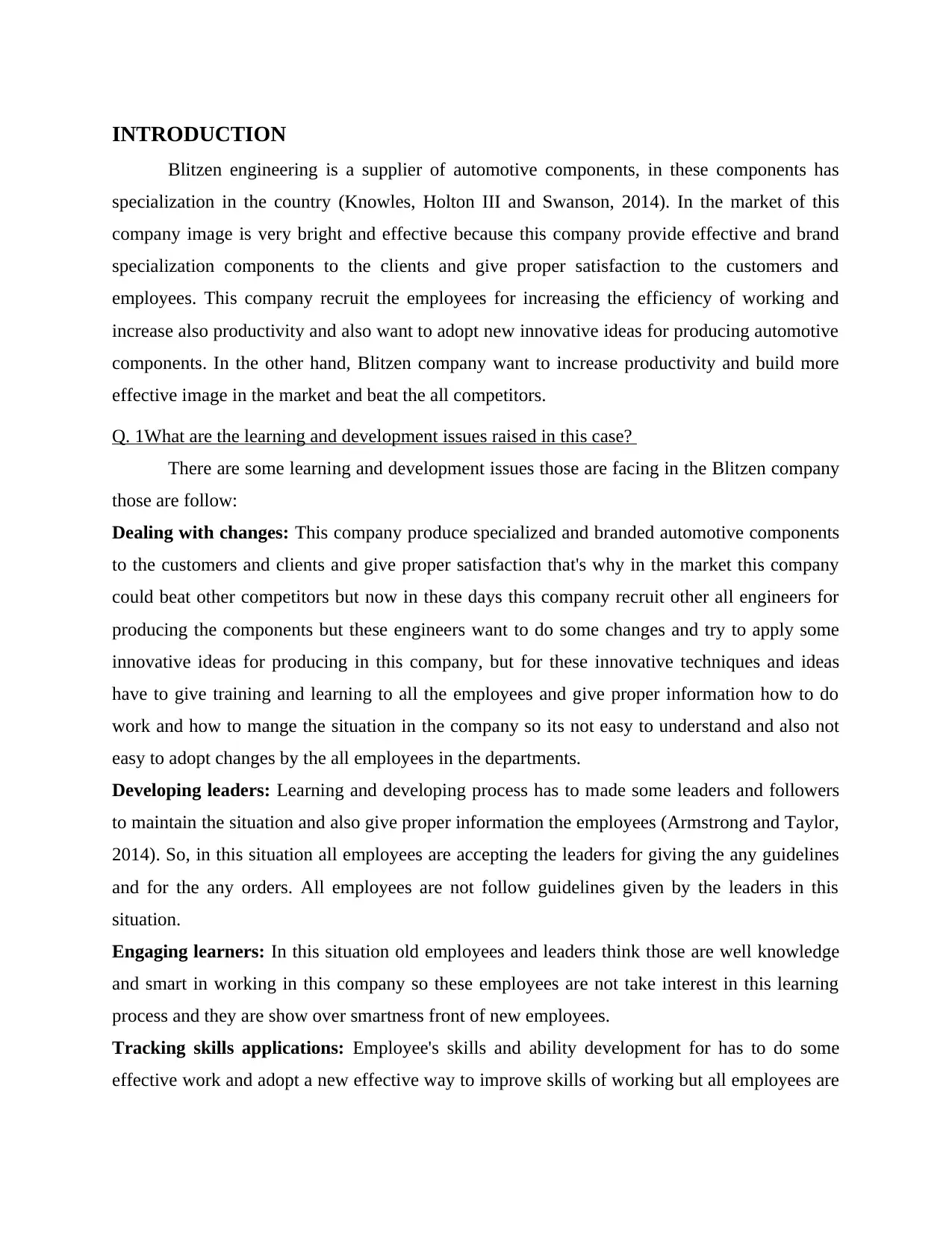
INTRODUCTION
Blitzen engineering is a supplier of automotive components, in these components has
specialization in the country (Knowles, Holton III and Swanson, 2014). In the market of this
company image is very bright and effective because this company provide effective and brand
specialization components to the clients and give proper satisfaction to the customers and
employees. This company recruit the employees for increasing the efficiency of working and
increase also productivity and also want to adopt new innovative ideas for producing automotive
components. In the other hand, Blitzen company want to increase productivity and build more
effective image in the market and beat the all competitors.
Q. 1What are the learning and development issues raised in this case?
There are some learning and development issues those are facing in the Blitzen company
those are follow:
Dealing with changes: This company produce specialized and branded automotive components
to the customers and clients and give proper satisfaction that's why in the market this company
could beat other competitors but now in these days this company recruit other all engineers for
producing the components but these engineers want to do some changes and try to apply some
innovative ideas for producing in this company, but for these innovative techniques and ideas
have to give training and learning to all the employees and give proper information how to do
work and how to mange the situation in the company so its not easy to understand and also not
easy to adopt changes by the all employees in the departments.
Developing leaders: Learning and developing process has to made some leaders and followers
to maintain the situation and also give proper information the employees (Armstrong and Taylor,
2014). So, in this situation all employees are accepting the leaders for giving the any guidelines
and for the any orders. All employees are not follow guidelines given by the leaders in this
situation.
Engaging learners: In this situation old employees and leaders think those are well knowledge
and smart in working in this company so these employees are not take interest in this learning
process and they are show over smartness front of new employees.
Tracking skills applications: Employee's skills and ability development for has to do some
effective work and adopt a new effective way to improve skills of working but all employees are
Blitzen engineering is a supplier of automotive components, in these components has
specialization in the country (Knowles, Holton III and Swanson, 2014). In the market of this
company image is very bright and effective because this company provide effective and brand
specialization components to the clients and give proper satisfaction to the customers and
employees. This company recruit the employees for increasing the efficiency of working and
increase also productivity and also want to adopt new innovative ideas for producing automotive
components. In the other hand, Blitzen company want to increase productivity and build more
effective image in the market and beat the all competitors.
Q. 1What are the learning and development issues raised in this case?
There are some learning and development issues those are facing in the Blitzen company
those are follow:
Dealing with changes: This company produce specialized and branded automotive components
to the customers and clients and give proper satisfaction that's why in the market this company
could beat other competitors but now in these days this company recruit other all engineers for
producing the components but these engineers want to do some changes and try to apply some
innovative ideas for producing in this company, but for these innovative techniques and ideas
have to give training and learning to all the employees and give proper information how to do
work and how to mange the situation in the company so its not easy to understand and also not
easy to adopt changes by the all employees in the departments.
Developing leaders: Learning and developing process has to made some leaders and followers
to maintain the situation and also give proper information the employees (Armstrong and Taylor,
2014). So, in this situation all employees are accepting the leaders for giving the any guidelines
and for the any orders. All employees are not follow guidelines given by the leaders in this
situation.
Engaging learners: In this situation old employees and leaders think those are well knowledge
and smart in working in this company so these employees are not take interest in this learning
process and they are show over smartness front of new employees.
Tracking skills applications: Employee's skills and ability development for has to do some
effective work and adopt a new effective way to improve skills of working but all employees are
⊘ This is a preview!⊘
Do you want full access?
Subscribe today to unlock all pages.

Trusted by 1+ million students worldwide
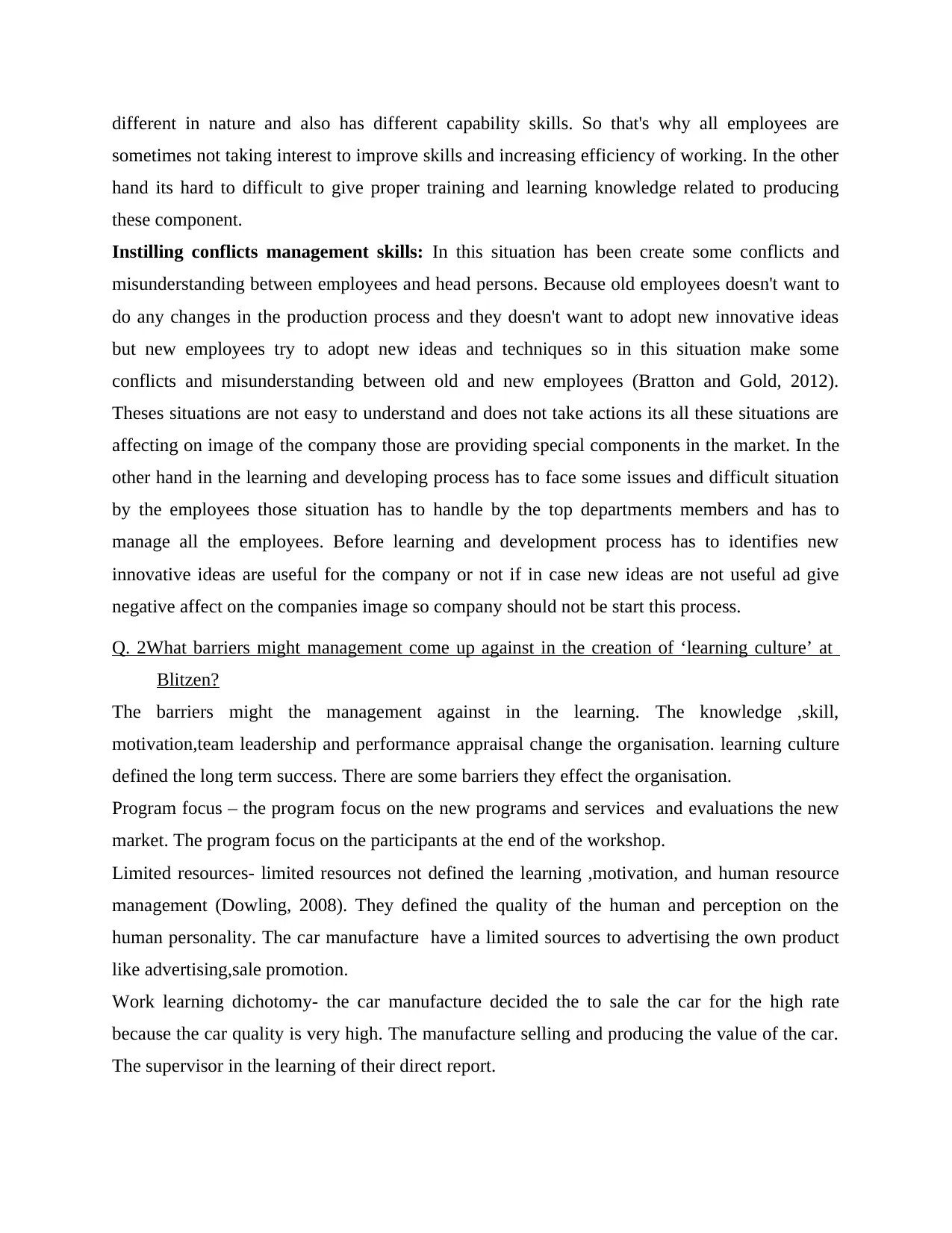
different in nature and also has different capability skills. So that's why all employees are
sometimes not taking interest to improve skills and increasing efficiency of working. In the other
hand its hard to difficult to give proper training and learning knowledge related to producing
these component.
Instilling conflicts management skills: In this situation has been create some conflicts and
misunderstanding between employees and head persons. Because old employees doesn't want to
do any changes in the production process and they doesn't want to adopt new innovative ideas
but new employees try to adopt new ideas and techniques so in this situation make some
conflicts and misunderstanding between old and new employees (Bratton and Gold, 2012).
Theses situations are not easy to understand and does not take actions its all these situations are
affecting on image of the company those are providing special components in the market. In the
other hand in the learning and developing process has to face some issues and difficult situation
by the employees those situation has to handle by the top departments members and has to
manage all the employees. Before learning and development process has to identifies new
innovative ideas are useful for the company or not if in case new ideas are not useful ad give
negative affect on the companies image so company should not be start this process.
Q. 2What barriers might management come up against in the creation of ‘learning culture’ at
Blitzen?
The barriers might the management against in the learning. The knowledge ,skill,
motivation,team leadership and performance appraisal change the organisation. learning culture
defined the long term success. There are some barriers they effect the organisation.
Program focus – the program focus on the new programs and services and evaluations the new
market. The program focus on the participants at the end of the workshop.
Limited resources- limited resources not defined the learning ,motivation, and human resource
management (Dowling, 2008). They defined the quality of the human and perception on the
human personality. The car manufacture have a limited sources to advertising the own product
like advertising,sale promotion.
Work learning dichotomy- the car manufacture decided the to sale the car for the high rate
because the car quality is very high. The manufacture selling and producing the value of the car.
The supervisor in the learning of their direct report.
sometimes not taking interest to improve skills and increasing efficiency of working. In the other
hand its hard to difficult to give proper training and learning knowledge related to producing
these component.
Instilling conflicts management skills: In this situation has been create some conflicts and
misunderstanding between employees and head persons. Because old employees doesn't want to
do any changes in the production process and they doesn't want to adopt new innovative ideas
but new employees try to adopt new ideas and techniques so in this situation make some
conflicts and misunderstanding between old and new employees (Bratton and Gold, 2012).
Theses situations are not easy to understand and does not take actions its all these situations are
affecting on image of the company those are providing special components in the market. In the
other hand in the learning and developing process has to face some issues and difficult situation
by the employees those situation has to handle by the top departments members and has to
manage all the employees. Before learning and development process has to identifies new
innovative ideas are useful for the company or not if in case new ideas are not useful ad give
negative affect on the companies image so company should not be start this process.
Q. 2What barriers might management come up against in the creation of ‘learning culture’ at
Blitzen?
The barriers might the management against in the learning. The knowledge ,skill,
motivation,team leadership and performance appraisal change the organisation. learning culture
defined the long term success. There are some barriers they effect the organisation.
Program focus – the program focus on the new programs and services and evaluations the new
market. The program focus on the participants at the end of the workshop.
Limited resources- limited resources not defined the learning ,motivation, and human resource
management (Dowling, 2008). They defined the quality of the human and perception on the
human personality. The car manufacture have a limited sources to advertising the own product
like advertising,sale promotion.
Work learning dichotomy- the car manufacture decided the to sale the car for the high rate
because the car quality is very high. The manufacture selling and producing the value of the car.
The supervisor in the learning of their direct report.
Paraphrase This Document
Need a fresh take? Get an instant paraphrase of this document with our AI Paraphraser
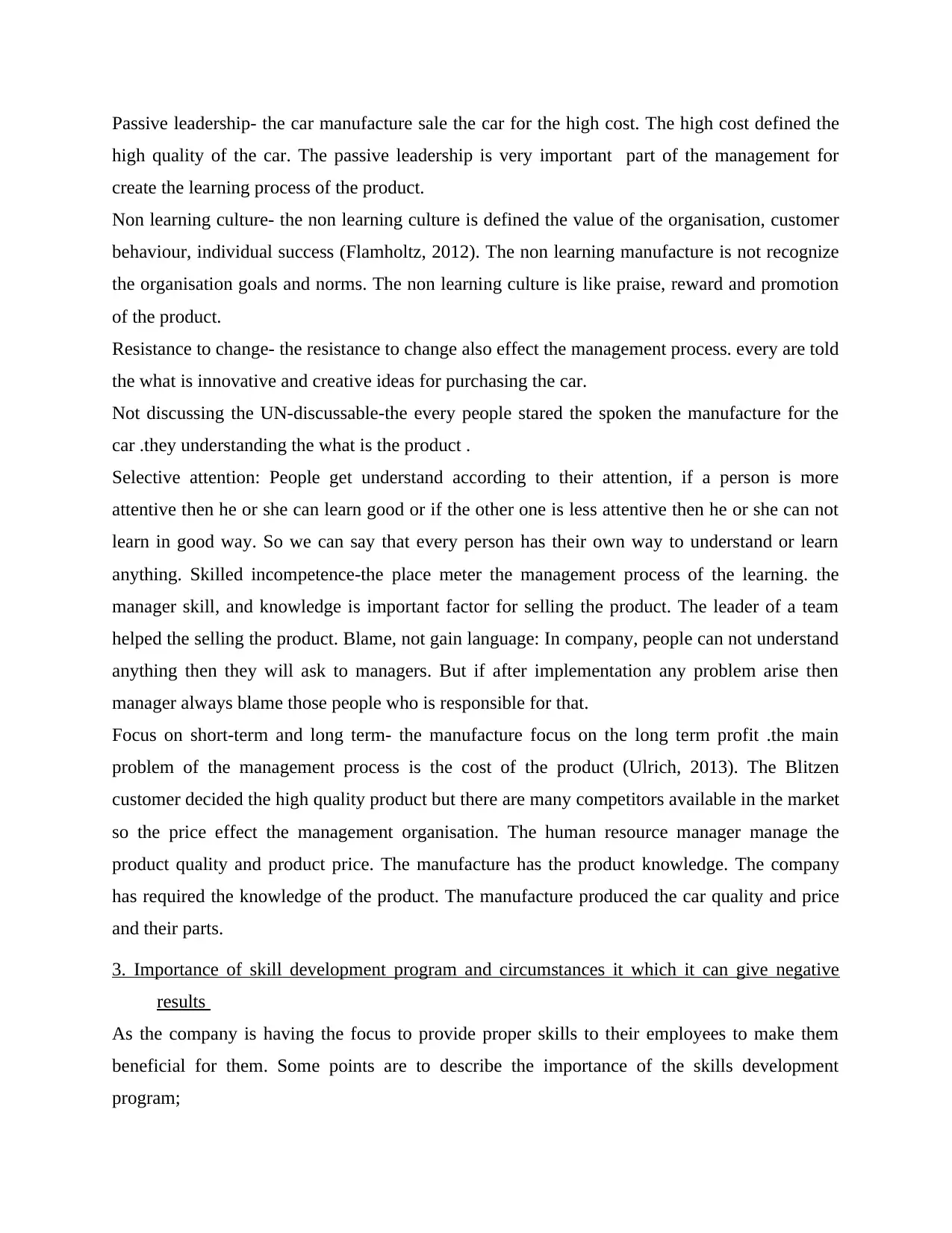
Passive leadership- the car manufacture sale the car for the high cost. The high cost defined the
high quality of the car. The passive leadership is very important part of the management for
create the learning process of the product.
Non learning culture- the non learning culture is defined the value of the organisation, customer
behaviour, individual success (Flamholtz, 2012). The non learning manufacture is not recognize
the organisation goals and norms. The non learning culture is like praise, reward and promotion
of the product.
Resistance to change- the resistance to change also effect the management process. every are told
the what is innovative and creative ideas for purchasing the car.
Not discussing the UN-discussable-the every people stared the spoken the manufacture for the
car .they understanding the what is the product .
Selective attention: People get understand according to their attention, if a person is more
attentive then he or she can learn good or if the other one is less attentive then he or she can not
learn in good way. So we can say that every person has their own way to understand or learn
anything. Skilled incompetence-the place meter the management process of the learning. the
manager skill, and knowledge is important factor for selling the product. The leader of a team
helped the selling the product. Blame, not gain language: In company, people can not understand
anything then they will ask to managers. But if after implementation any problem arise then
manager always blame those people who is responsible for that.
Focus on short-term and long term- the manufacture focus on the long term profit .the main
problem of the management process is the cost of the product (Ulrich, 2013). The Blitzen
customer decided the high quality product but there are many competitors available in the market
so the price effect the management organisation. The human resource manager manage the
product quality and product price. The manufacture has the product knowledge. The company
has required the knowledge of the product. The manufacture produced the car quality and price
and their parts.
3. Importance of skill development program and circumstances it which it can give negative
results
As the company is having the focus to provide proper skills to their employees to make them
beneficial for them. Some points are to describe the importance of the skills development
program;
high quality of the car. The passive leadership is very important part of the management for
create the learning process of the product.
Non learning culture- the non learning culture is defined the value of the organisation, customer
behaviour, individual success (Flamholtz, 2012). The non learning manufacture is not recognize
the organisation goals and norms. The non learning culture is like praise, reward and promotion
of the product.
Resistance to change- the resistance to change also effect the management process. every are told
the what is innovative and creative ideas for purchasing the car.
Not discussing the UN-discussable-the every people stared the spoken the manufacture for the
car .they understanding the what is the product .
Selective attention: People get understand according to their attention, if a person is more
attentive then he or she can learn good or if the other one is less attentive then he or she can not
learn in good way. So we can say that every person has their own way to understand or learn
anything. Skilled incompetence-the place meter the management process of the learning. the
manager skill, and knowledge is important factor for selling the product. The leader of a team
helped the selling the product. Blame, not gain language: In company, people can not understand
anything then they will ask to managers. But if after implementation any problem arise then
manager always blame those people who is responsible for that.
Focus on short-term and long term- the manufacture focus on the long term profit .the main
problem of the management process is the cost of the product (Ulrich, 2013). The Blitzen
customer decided the high quality product but there are many competitors available in the market
so the price effect the management organisation. The human resource manager manage the
product quality and product price. The manufacture has the product knowledge. The company
has required the knowledge of the product. The manufacture produced the car quality and price
and their parts.
3. Importance of skill development program and circumstances it which it can give negative
results
As the company is having the focus to provide proper skills to their employees to make them
beneficial for them. Some points are to describe the importance of the skills development
program;
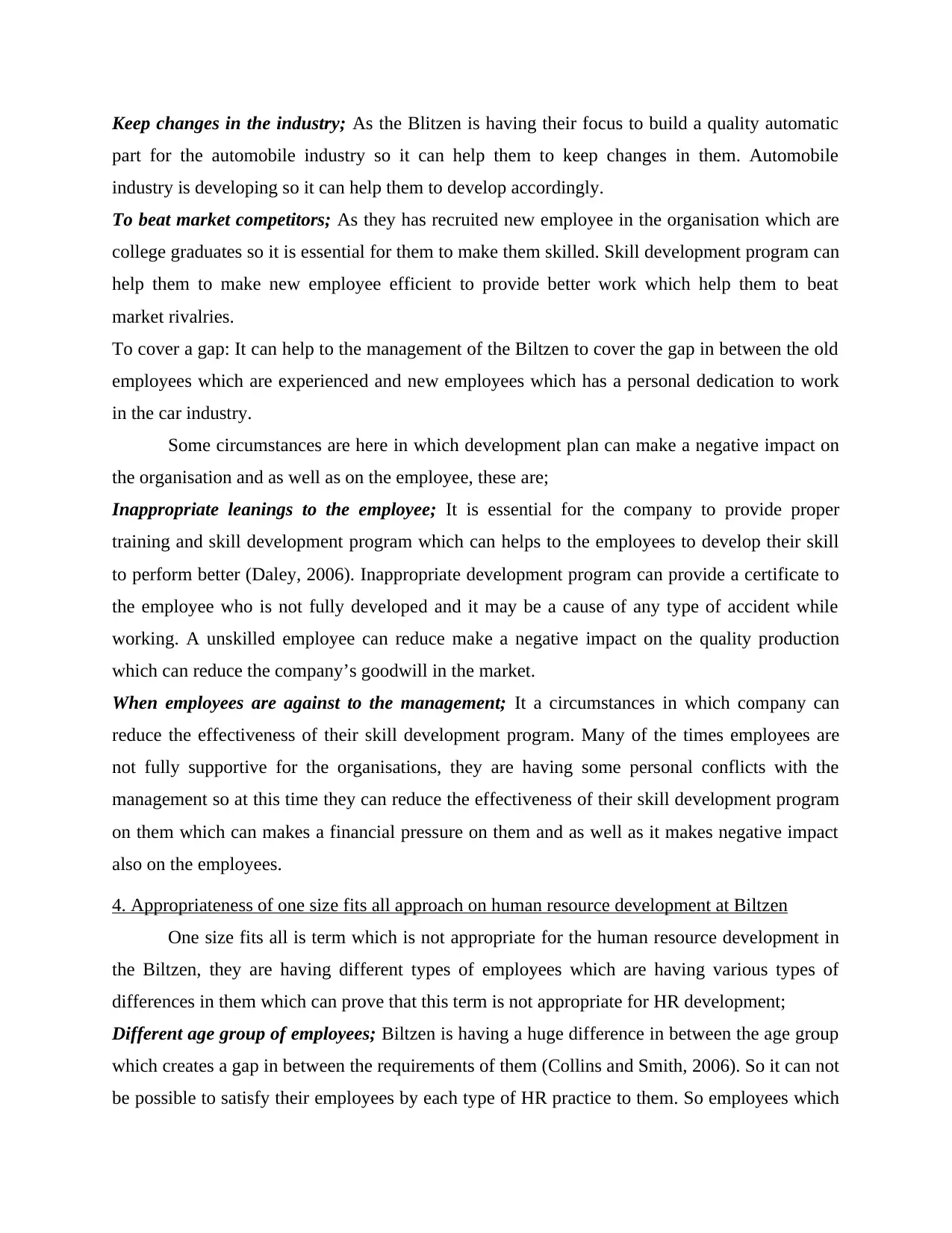
Keep changes in the industry; As the Blitzen is having their focus to build a quality automatic
part for the automobile industry so it can help them to keep changes in them. Automobile
industry is developing so it can help them to develop accordingly.
To beat market competitors; As they has recruited new employee in the organisation which are
college graduates so it is essential for them to make them skilled. Skill development program can
help them to make new employee efficient to provide better work which help them to beat
market rivalries.
To cover a gap: It can help to the management of the Biltzen to cover the gap in between the old
employees which are experienced and new employees which has a personal dedication to work
in the car industry.
Some circumstances are here in which development plan can make a negative impact on
the organisation and as well as on the employee, these are;
Inappropriate leanings to the employee; It is essential for the company to provide proper
training and skill development program which can helps to the employees to develop their skill
to perform better (Daley, 2006). Inappropriate development program can provide a certificate to
the employee who is not fully developed and it may be a cause of any type of accident while
working. A unskilled employee can reduce make a negative impact on the quality production
which can reduce the company’s goodwill in the market.
When employees are against to the management; It a circumstances in which company can
reduce the effectiveness of their skill development program. Many of the times employees are
not fully supportive for the organisations, they are having some personal conflicts with the
management so at this time they can reduce the effectiveness of their skill development program
on them which can makes a financial pressure on them and as well as it makes negative impact
also on the employees.
4. Appropriateness of one size fits all approach on human resource development at Biltzen
One size fits all is term which is not appropriate for the human resource development in
the Biltzen, they are having different types of employees which are having various types of
differences in them which can prove that this term is not appropriate for HR development;
Different age group of employees; Biltzen is having a huge difference in between the age group
which creates a gap in between the requirements of them (Collins and Smith, 2006). So it can not
be possible to satisfy their employees by each type of HR practice to them. So employees which
part for the automobile industry so it can help them to keep changes in them. Automobile
industry is developing so it can help them to develop accordingly.
To beat market competitors; As they has recruited new employee in the organisation which are
college graduates so it is essential for them to make them skilled. Skill development program can
help them to make new employee efficient to provide better work which help them to beat
market rivalries.
To cover a gap: It can help to the management of the Biltzen to cover the gap in between the old
employees which are experienced and new employees which has a personal dedication to work
in the car industry.
Some circumstances are here in which development plan can make a negative impact on
the organisation and as well as on the employee, these are;
Inappropriate leanings to the employee; It is essential for the company to provide proper
training and skill development program which can helps to the employees to develop their skill
to perform better (Daley, 2006). Inappropriate development program can provide a certificate to
the employee who is not fully developed and it may be a cause of any type of accident while
working. A unskilled employee can reduce make a negative impact on the quality production
which can reduce the company’s goodwill in the market.
When employees are against to the management; It a circumstances in which company can
reduce the effectiveness of their skill development program. Many of the times employees are
not fully supportive for the organisations, they are having some personal conflicts with the
management so at this time they can reduce the effectiveness of their skill development program
on them which can makes a financial pressure on them and as well as it makes negative impact
also on the employees.
4. Appropriateness of one size fits all approach on human resource development at Biltzen
One size fits all is term which is not appropriate for the human resource development in
the Biltzen, they are having different types of employees which are having various types of
differences in them which can prove that this term is not appropriate for HR development;
Different age group of employees; Biltzen is having a huge difference in between the age group
which creates a gap in between the requirements of them (Collins and Smith, 2006). So it can not
be possible to satisfy their employees by each type of HR practice to them. So employees which
⊘ This is a preview!⊘
Do you want full access?
Subscribe today to unlock all pages.

Trusted by 1+ million students worldwide
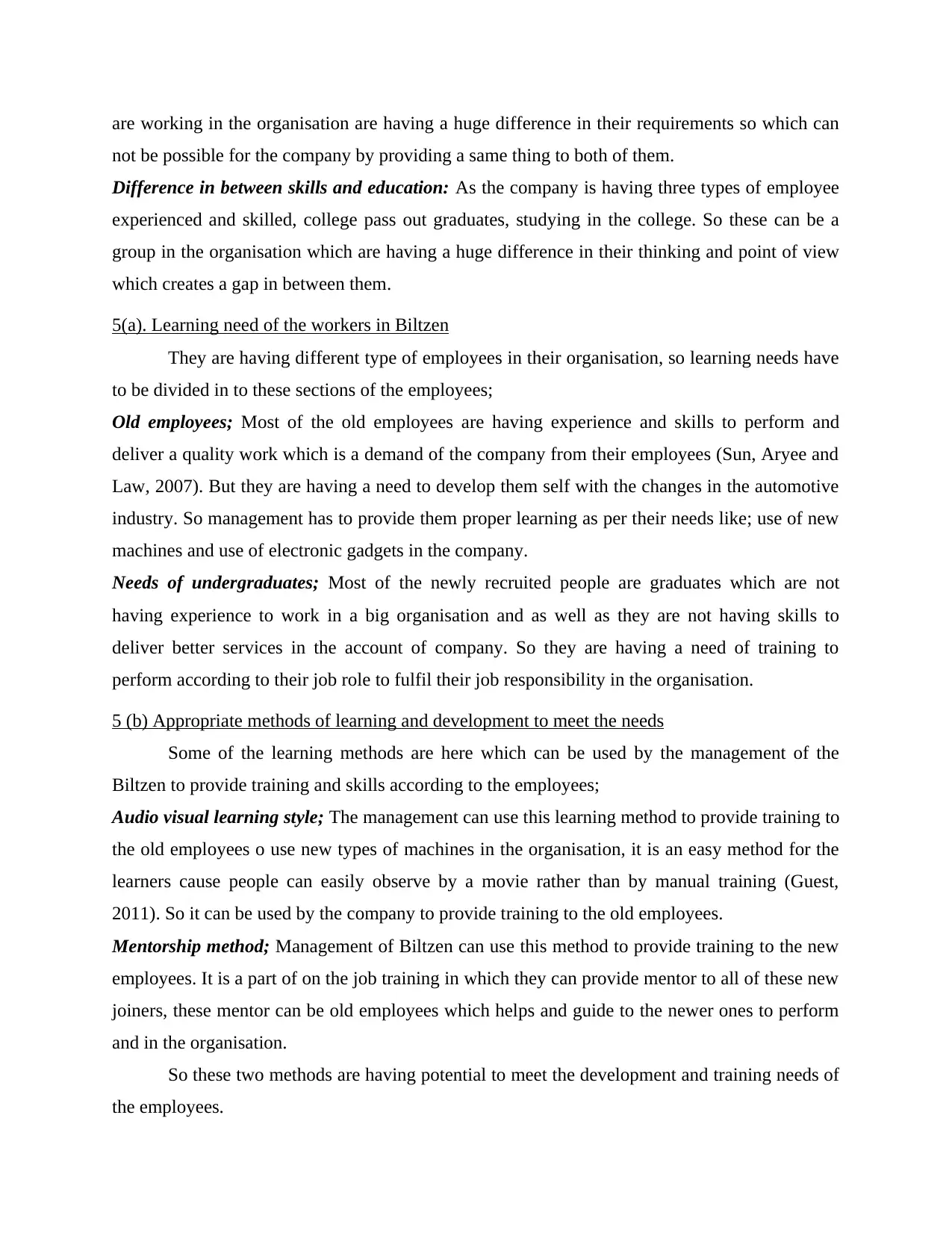
are working in the organisation are having a huge difference in their requirements so which can
not be possible for the company by providing a same thing to both of them.
Difference in between skills and education: As the company is having three types of employee
experienced and skilled, college pass out graduates, studying in the college. So these can be a
group in the organisation which are having a huge difference in their thinking and point of view
which creates a gap in between them.
5(a). Learning need of the workers in Biltzen
They are having different type of employees in their organisation, so learning needs have
to be divided in to these sections of the employees;
Old employees; Most of the old employees are having experience and skills to perform and
deliver a quality work which is a demand of the company from their employees (Sun, Aryee and
Law, 2007). But they are having a need to develop them self with the changes in the automotive
industry. So management has to provide them proper learning as per their needs like; use of new
machines and use of electronic gadgets in the company.
Needs of undergraduates; Most of the newly recruited people are graduates which are not
having experience to work in a big organisation and as well as they are not having skills to
deliver better services in the account of company. So they are having a need of training to
perform according to their job role to fulfil their job responsibility in the organisation.
5 (b) Appropriate methods of learning and development to meet the needs
Some of the learning methods are here which can be used by the management of the
Biltzen to provide training and skills according to the employees;
Audio visual learning style; The management can use this learning method to provide training to
the old employees o use new types of machines in the organisation, it is an easy method for the
learners cause people can easily observe by a movie rather than by manual training (Guest,
2011). So it can be used by the company to provide training to the old employees.
Mentorship method; Management of Biltzen can use this method to provide training to the new
employees. It is a part of on the job training in which they can provide mentor to all of these new
joiners, these mentor can be old employees which helps and guide to the newer ones to perform
and in the organisation.
So these two methods are having potential to meet the development and training needs of
the employees.
not be possible for the company by providing a same thing to both of them.
Difference in between skills and education: As the company is having three types of employee
experienced and skilled, college pass out graduates, studying in the college. So these can be a
group in the organisation which are having a huge difference in their thinking and point of view
which creates a gap in between them.
5(a). Learning need of the workers in Biltzen
They are having different type of employees in their organisation, so learning needs have
to be divided in to these sections of the employees;
Old employees; Most of the old employees are having experience and skills to perform and
deliver a quality work which is a demand of the company from their employees (Sun, Aryee and
Law, 2007). But they are having a need to develop them self with the changes in the automotive
industry. So management has to provide them proper learning as per their needs like; use of new
machines and use of electronic gadgets in the company.
Needs of undergraduates; Most of the newly recruited people are graduates which are not
having experience to work in a big organisation and as well as they are not having skills to
deliver better services in the account of company. So they are having a need of training to
perform according to their job role to fulfil their job responsibility in the organisation.
5 (b) Appropriate methods of learning and development to meet the needs
Some of the learning methods are here which can be used by the management of the
Biltzen to provide training and skills according to the employees;
Audio visual learning style; The management can use this learning method to provide training to
the old employees o use new types of machines in the organisation, it is an easy method for the
learners cause people can easily observe by a movie rather than by manual training (Guest,
2011). So it can be used by the company to provide training to the old employees.
Mentorship method; Management of Biltzen can use this method to provide training to the new
employees. It is a part of on the job training in which they can provide mentor to all of these new
joiners, these mentor can be old employees which helps and guide to the newer ones to perform
and in the organisation.
So these two methods are having potential to meet the development and training needs of
the employees.
Paraphrase This Document
Need a fresh take? Get an instant paraphrase of this document with our AI Paraphraser
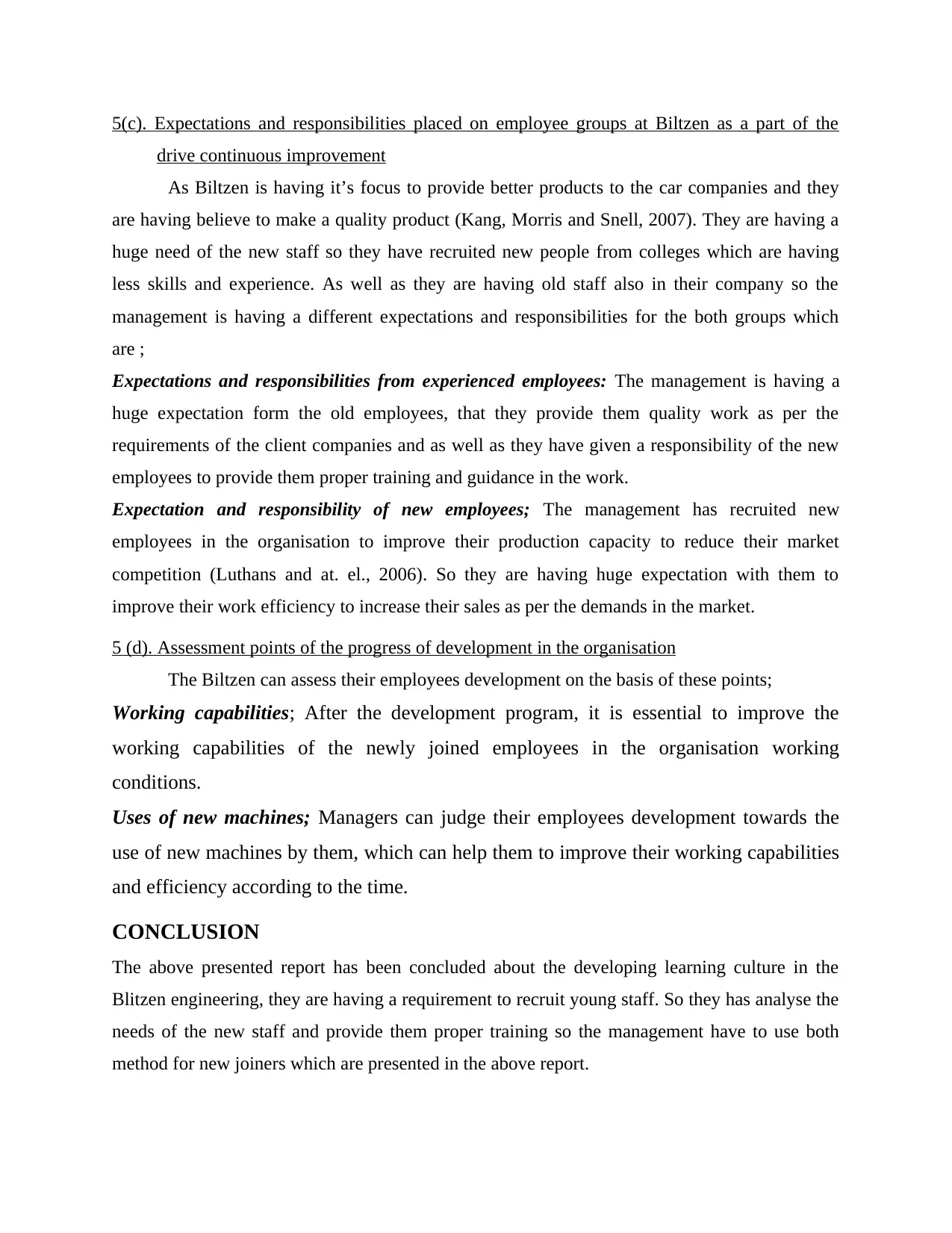
5(c). Expectations and responsibilities placed on employee groups at Biltzen as a part of the
drive continuous improvement
As Biltzen is having it’s focus to provide better products to the car companies and they
are having believe to make a quality product (Kang, Morris and Snell, 2007). They are having a
huge need of the new staff so they have recruited new people from colleges which are having
less skills and experience. As well as they are having old staff also in their company so the
management is having a different expectations and responsibilities for the both groups which
are ;
Expectations and responsibilities from experienced employees: The management is having a
huge expectation form the old employees, that they provide them quality work as per the
requirements of the client companies and as well as they have given a responsibility of the new
employees to provide them proper training and guidance in the work.
Expectation and responsibility of new employees; The management has recruited new
employees in the organisation to improve their production capacity to reduce their market
competition (Luthans and at. el., 2006). So they are having huge expectation with them to
improve their work efficiency to increase their sales as per the demands in the market.
5 (d). Assessment points of the progress of development in the organisation
The Biltzen can assess their employees development on the basis of these points;
Working capabilities; After the development program, it is essential to improve the
working capabilities of the newly joined employees in the organisation working
conditions.
Uses of new machines; Managers can judge their employees development towards the
use of new machines by them, which can help them to improve their working capabilities
and efficiency according to the time.
CONCLUSION
The above presented report has been concluded about the developing learning culture in the
Blitzen engineering, they are having a requirement to recruit young staff. So they has analyse the
needs of the new staff and provide them proper training so the management have to use both
method for new joiners which are presented in the above report.
drive continuous improvement
As Biltzen is having it’s focus to provide better products to the car companies and they
are having believe to make a quality product (Kang, Morris and Snell, 2007). They are having a
huge need of the new staff so they have recruited new people from colleges which are having
less skills and experience. As well as they are having old staff also in their company so the
management is having a different expectations and responsibilities for the both groups which
are ;
Expectations and responsibilities from experienced employees: The management is having a
huge expectation form the old employees, that they provide them quality work as per the
requirements of the client companies and as well as they have given a responsibility of the new
employees to provide them proper training and guidance in the work.
Expectation and responsibility of new employees; The management has recruited new
employees in the organisation to improve their production capacity to reduce their market
competition (Luthans and at. el., 2006). So they are having huge expectation with them to
improve their work efficiency to increase their sales as per the demands in the market.
5 (d). Assessment points of the progress of development in the organisation
The Biltzen can assess their employees development on the basis of these points;
Working capabilities; After the development program, it is essential to improve the
working capabilities of the newly joined employees in the organisation working
conditions.
Uses of new machines; Managers can judge their employees development towards the
use of new machines by them, which can help them to improve their working capabilities
and efficiency according to the time.
CONCLUSION
The above presented report has been concluded about the developing learning culture in the
Blitzen engineering, they are having a requirement to recruit young staff. So they has analyse the
needs of the new staff and provide them proper training so the management have to use both
method for new joiners which are presented in the above report.
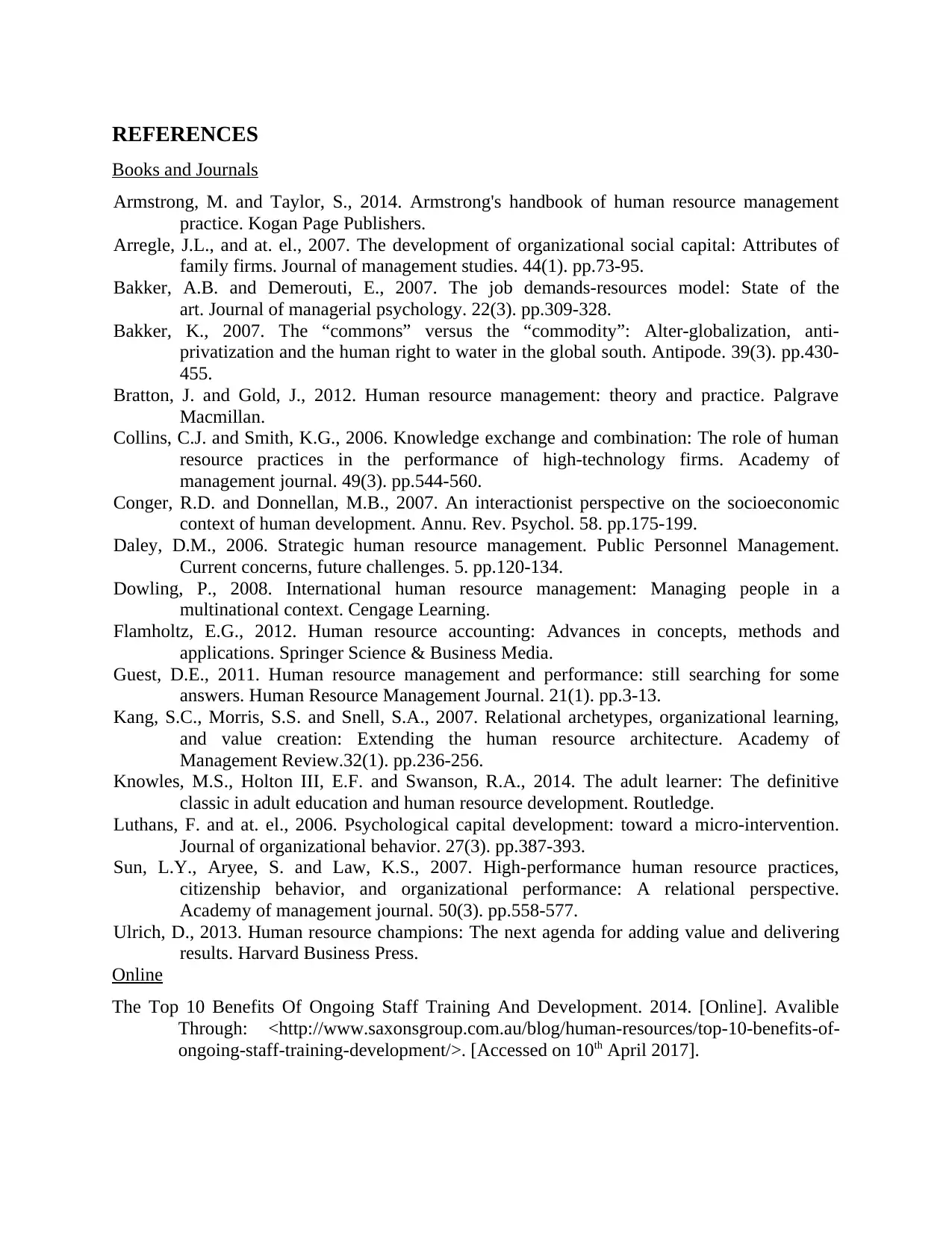
REFERENCES
Books and Journals
Armstrong, M. and Taylor, S., 2014. Armstrong's handbook of human resource management
practice. Kogan Page Publishers.
Arregle, J.L., and at. el., 2007. The development of organizational social capital: Attributes of
family firms. Journal of management studies. 44(1). pp.73-95.
Bakker, A.B. and Demerouti, E., 2007. The job demands-resources model: State of the
art. Journal of managerial psychology. 22(3). pp.309-328.
Bakker, K., 2007. The “commons” versus the “commodity”: Alter‐globalization, anti‐
privatization and the human right to water in the global south. Antipode. 39(3). pp.430-
455.
Bratton, J. and Gold, J., 2012. Human resource management: theory and practice. Palgrave
Macmillan.
Collins, C.J. and Smith, K.G., 2006. Knowledge exchange and combination: The role of human
resource practices in the performance of high-technology firms. Academy of
management journal. 49(3). pp.544-560.
Conger, R.D. and Donnellan, M.B., 2007. An interactionist perspective on the socioeconomic
context of human development. Annu. Rev. Psychol. 58. pp.175-199.
Daley, D.M., 2006. Strategic human resource management. Public Personnel Management.
Current concerns, future challenges. 5. pp.120-134.
Dowling, P., 2008. International human resource management: Managing people in a
multinational context. Cengage Learning.
Flamholtz, E.G., 2012. Human resource accounting: Advances in concepts, methods and
applications. Springer Science & Business Media.
Guest, D.E., 2011. Human resource management and performance: still searching for some
answers. Human Resource Management Journal. 21(1). pp.3-13.
Kang, S.C., Morris, S.S. and Snell, S.A., 2007. Relational archetypes, organizational learning,
and value creation: Extending the human resource architecture. Academy of
Management Review.32(1). pp.236-256.
Knowles, M.S., Holton III, E.F. and Swanson, R.A., 2014. The adult learner: The definitive
classic in adult education and human resource development. Routledge.
Luthans, F. and at. el., 2006. Psychological capital development: toward a micro‐intervention.
Journal of organizational behavior. 27(3). pp.387-393.
Sun, L.Y., Aryee, S. and Law, K.S., 2007. High-performance human resource practices,
citizenship behavior, and organizational performance: A relational perspective.
Academy of management journal. 50(3). pp.558-577.
Ulrich, D., 2013. Human resource champions: The next agenda for adding value and delivering
results. Harvard Business Press.
Online
The Top 10 Benefits Of Ongoing Staff Training And Development. 2014. [Online]. Avalible
Through: <http://www.saxonsgroup.com.au/blog/human-resources/top-10-benefits-of-
ongoing-staff-training-development/>. [Accessed on 10th April 2017].
Books and Journals
Armstrong, M. and Taylor, S., 2014. Armstrong's handbook of human resource management
practice. Kogan Page Publishers.
Arregle, J.L., and at. el., 2007. The development of organizational social capital: Attributes of
family firms. Journal of management studies. 44(1). pp.73-95.
Bakker, A.B. and Demerouti, E., 2007. The job demands-resources model: State of the
art. Journal of managerial psychology. 22(3). pp.309-328.
Bakker, K., 2007. The “commons” versus the “commodity”: Alter‐globalization, anti‐
privatization and the human right to water in the global south. Antipode. 39(3). pp.430-
455.
Bratton, J. and Gold, J., 2012. Human resource management: theory and practice. Palgrave
Macmillan.
Collins, C.J. and Smith, K.G., 2006. Knowledge exchange and combination: The role of human
resource practices in the performance of high-technology firms. Academy of
management journal. 49(3). pp.544-560.
Conger, R.D. and Donnellan, M.B., 2007. An interactionist perspective on the socioeconomic
context of human development. Annu. Rev. Psychol. 58. pp.175-199.
Daley, D.M., 2006. Strategic human resource management. Public Personnel Management.
Current concerns, future challenges. 5. pp.120-134.
Dowling, P., 2008. International human resource management: Managing people in a
multinational context. Cengage Learning.
Flamholtz, E.G., 2012. Human resource accounting: Advances in concepts, methods and
applications. Springer Science & Business Media.
Guest, D.E., 2011. Human resource management and performance: still searching for some
answers. Human Resource Management Journal. 21(1). pp.3-13.
Kang, S.C., Morris, S.S. and Snell, S.A., 2007. Relational archetypes, organizational learning,
and value creation: Extending the human resource architecture. Academy of
Management Review.32(1). pp.236-256.
Knowles, M.S., Holton III, E.F. and Swanson, R.A., 2014. The adult learner: The definitive
classic in adult education and human resource development. Routledge.
Luthans, F. and at. el., 2006. Psychological capital development: toward a micro‐intervention.
Journal of organizational behavior. 27(3). pp.387-393.
Sun, L.Y., Aryee, S. and Law, K.S., 2007. High-performance human resource practices,
citizenship behavior, and organizational performance: A relational perspective.
Academy of management journal. 50(3). pp.558-577.
Ulrich, D., 2013. Human resource champions: The next agenda for adding value and delivering
results. Harvard Business Press.
Online
The Top 10 Benefits Of Ongoing Staff Training And Development. 2014. [Online]. Avalible
Through: <http://www.saxonsgroup.com.au/blog/human-resources/top-10-benefits-of-
ongoing-staff-training-development/>. [Accessed on 10th April 2017].
⊘ This is a preview!⊘
Do you want full access?
Subscribe today to unlock all pages.

Trusted by 1+ million students worldwide
1 out of 9
Related Documents
Your All-in-One AI-Powered Toolkit for Academic Success.
+13062052269
info@desklib.com
Available 24*7 on WhatsApp / Email
![[object Object]](/_next/static/media/star-bottom.7253800d.svg)
Unlock your academic potential
Copyright © 2020–2025 A2Z Services. All Rights Reserved. Developed and managed by ZUCOL.





